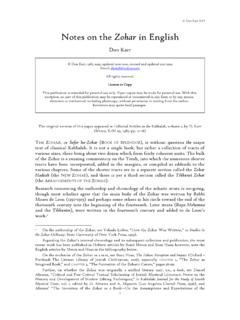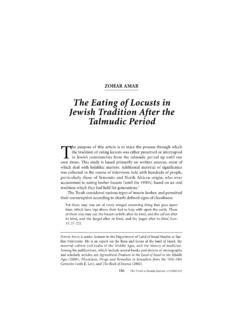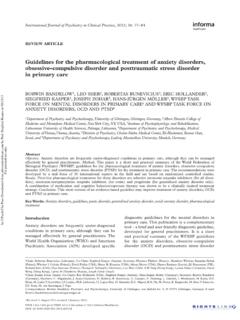Transcription of Understanding Safety Culture and Safety Climate in ...
1 8484 Georgia AvenueSuite 1000 Silver Spring, MD 20910phone: : Safety Culture and Safety Climate in construction : existing evidence and a Path Forward Literature Review Summary for Safety Culture / Climate Workshop June 11-12, 2013 Washington, DCJanuary 2014 Steven Hecker, MSPHL inda Goldenhar, PhD 2014, CPWR The Center for construction Research and Training. CPWR, the research and training arm of the Building and construction Trades Dept., AFL-CIO, is uniquely situated to serve construction workers, contractors, practitioners, and the scientific community. This report was prepared by the authors noted. Funding for this research study was made possible by a cooperative agreement with the National Institute for Occupational Safety and Health, NIOSH (OH009762).
2 The contents are solely the responsibility of the authors and do not necessarily represent the official views of NIOSH or CPWR. Understanding Safety Culture and Safety Climate in construction : existing evidence and a Path Forward Literature Review Summary for Safety Culture / Climate Workshop June 11 12, 2013 Washington, DC Prepared by Steven Hecker, Associate Professor Emeritus, University of Oregon and Linda M. Goldenhar PhD, Director, Intervention Research, CPWR Man is an animal suspended in webs of significance he himself has spun; I take Culture to be those webs. (Geertz 1973) 2 Understanding Safety Culture and Safety Climate in construction : existing evidence and a Path Forward Definitions and Historical Framework Safety Culture and Safety Climate are constructs that evolved in the 1980s from the broader concepts of organizational Culture and organizational Climate .
3 Organizational Culture and Climate have different meanings including when the focus is more specifically on Safety . Unfortunately, neither the research literature nor the practical application of these concepts has offered clear or consistent distinctions, which has resulted in considerable definitional confusion. For this review, we have chosen just a few definitions that we believe capture the essence of Safety Culture and Safety Climate and help address the cause and effect debate. Some authors (Guldenmund 2000; Schein, 1992) present a model of Culture and Climate as a layered phenomenon where the core of Culture (the inner layers) comprise constructs such as basic values, assumptions, principles, or convictions and the more visible expressions of Culture like rituals, artifacts, and heroes, are located in the outer layers Another way authors attempt to clarify these concepts is by analogy with the study of personality as in: Culture is analogous to the relatively fixed personality trait, while Climate corresponds to the more variable mood state (Cox & Flin 1998), or through other familiar terminology.
4 Climate is commonly associated with terms such as superficial .. snapshot, quantitative, and state, whereas Culture with deep, stable, qualitative, and trait. (Seo et al. 2004). Safety Culture The origin of the Safety Culture concept is easily traced. The International Atomic Energy Agency (IAEA) and OECD Nuclear Agency identified poor Safety Culture as a prominent factor in the 1986 Chernobyl nuclear disaster in the former Soviet Union (Cox & Flin, 1998). Soon thereafter the Safety Culture theme was also applied to major disasters in transportation (Kings Cross underground fire London 1987; Clapham Junction rail crash London 1988), and offshore oil production (Piper Alpha platform explosion North Sea 1988), among others (Cox & Flin 1998).
5 A UK nuclear Safety panel developed a definition of Safety Culture that became the market standard in that country: The Safety Culture of an organisation is the product of individual and group values, attitudes, perceptions, competencies, and patterns of behaviour that determine the commitment to, and the style and proficiency of, an organisation s health and Safety management (HSC 1993, 23). 3 (Glendon 2008) The above figure illustrates the degree to which research on Safety Culture and Safety Climate took off in the 1990s and beyond. A great deal of the early research took place in the so called high reliability industries of nuclear power, offshore oil extraction, and commercial aviation, and this is where many concepts of Safety Culture were developed.
6 The high reliability organization (HRO) designation has subsequently penetrated health care and other sectors, but construction , despite its many risks, is not generally considered an HRO industry, except when construction services intersect with an HRO sector such as in nuclear reactor and petrochemical turnarounds and semiconductor fab construction and maintenance. This intersection has likely increased, particularly during the recent health care construction boom, and will probably continue to do so, but only for certain segments of the construction market. Safety Climate Zohar published the first Safety Climate study in 1980, where he developed and tested a model of Safety Climate using a 40 item questionnaire, which he administered to workers in 20 Israeli factories across a variety of industries.
7 He defined Safety Climate as a summary of molar perceptions that employees share about their work environment (Zohar 1980). This study established what has become the common way to assess Safety Climate : a questionnaire whose items (questions) measure a set of factors or constructs that reveal shared perceptions of the organization s Safety Climate . Zohar s original set of factors were: Importance of Safety training Effects of required work pace on Safety Status of Safety committee Status of Safety officer Effects of safe conduct on promotion Level of risk at work place Management attitudes toward Safety Effect of safe conduct on social status (Zohar 1980).
8 4 Many subsequent studies began from this list, but methodological and population differences have been a barrier to identifying a consistent core set of factors and definitions (Flin et al 2000). That said, Seo and colleagues (2004) concluded that the set of critical factors in subsequent literature had not significantly diverged from Zohar s original set, finding that the themes clustered into five core constructs of Safety Climate : management commitment to Safety , supervisory Safety support, coworker ( Safety ) support, employee ( Safety ) participation, and competence level. More on Measuring Safety Culture and Safety Climate Disciplinary Approaches Organizational and occupational psychologists have sought to uncover the structure of organizational Climate and Culture by developing questionnaires designed to measure and characterize it.
9 The questionnaire is administered to employees of an organization and quantitative results are psychometrically analyzed to reveal dimensions of the organization s Climate or Culture . (Psychometrics is the study of the theory and techniques of psychological measurement). The ethnographic method associated with anthropology is the qualitative counterpart to the psychological approach. It typically uses time and resource intensive interview and observational methods to uncover a group s strongly held, and perhaps not so apparent, core values to provide a better Understanding of its Culture . It is important to note that the term organizational Culture may give a false impression of a single integrated Culture , while many organizations may be characterized by multiple cultures or subcultures.
10 Referring to a single organizational Culture in construction may be particularly misleading since workers may be influenced more by acculturation into their trade, particularly through apprenticeship training, than by the organization for whom they work (Gherardi & Nicolini 2002). Furthermore, construction is also conducted on a project by project basis whereby numerous organizations come together for a period from weeks to years, bringing with them a variety of company, trade, and sometimes national or ethnic cultures and subcultures. Collecting and analyzing data via questionnaires is much less expensive and less time consuming than conducting in depth interviews and observations.

















